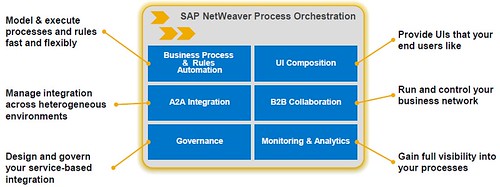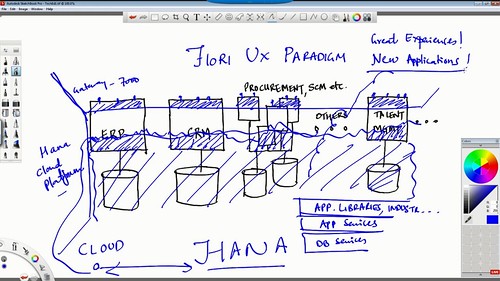It’s been a busy first day here at SAP TechEd, although some of that in briefings that I haven’t yet fully digested, and I’m finishing off with an update on NetWeaver Process Orchestration from Alexander Bundschuh (from the PI side) and Benjamin Notheis (from the BPM side). The goal of Process Orchestration is to improve processes and save integration costs, and it includes a number of tools:
For customers currently running a PI and BPM dual-stack system moving to the consolidated Process Orchestration stack, they can reduce their operational footprint by running them both on the same platform but also improve performance and stability because what were previously web service calls between PI and BPM are now direct Java calls on the same engine. There are some good resources on implementing enterprise integration patterns in Process Orchestration, they discussed a number of techniques for the migration:
- Migrating the ccBPM BPEL models over to BPMN
- Designing integration flows graphically in the Eclipse
- Using conditional process starts (for aggregator/correlation patterns where an inbound message event either matches with an existing process instance or starts a new one) which is a new feature in NW BPM,
- Using the new NW BPM inbox for human-centric tasks, using either a traditional inbox view or a stream view, and providing features such as enabling users to manage substitution rules for their out-of-office times (note that this is for BPM only, and not a UWL replacement for BW tasks)
- Integrated monitoring and administration between PI and BPM, allowing navigation from a BPM process instance to all associated PI messages, or from a PI message to the associated BPM process, plus graphical dashboards
- End-to-end integration visibility to allow transactions to be correlated and tracked across systems, including B2B scenarios
Process Orchestration is available using HANA as the database (BPM can use HANA as a database, although there are no BPM-specific services available yet on HANA), although that was done for infrastructure simplification purposes and doesn’t show any significant performance improvement; in the future, further refactoring will exploit HANA capabilities fully and should show a greater performance increase. Also on their roadmap are technical error handling in BPM, and some improved B2B trading partner and intelligent mapping capabilities.
Good update, with lots of great information for customers who are using both PI and BPM, and want to bring them together on a common stack.
There a number of other sessions on Process Orchestration here at TechEd Las Vegas, as well as at the upcoming Amsterdam and Bangalore events, and a section of the SAP Community Network (SCN) on Process Orchestration.



